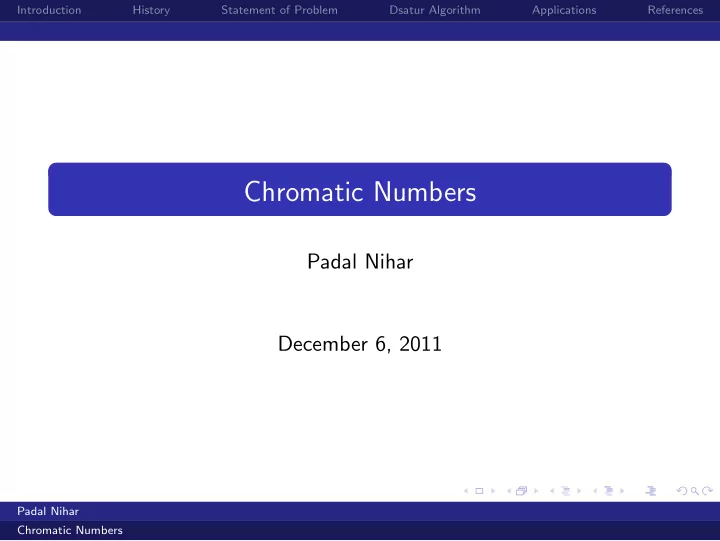

Introduction History Statement of Problem Dsatur Algorithm Applications References Chromatic Numbers Padal Nihar December 6, 2011 Padal Nihar Chromatic Numbers
Introduction History Statement of Problem Dsatur Algorithm Applications References Outline Introduction History Statement of Problem Dsatur Algorithm Applications Refereces Padal Nihar Chromatic Numbers
Introduction History Statement of Problem Dsatur Algorithm Applications References Introduction Definition : The smallest number of colors necessary to color the nodes of graph so that no two adjacent nodes have the same color. Chromatic Number of C 6 is : 2 Chromatic Number of k 6 is : 6 In general, a graph with chromatic number k is said to be an k -chromatic graph, and a graph with chromatic number ≤ k is said to be k -colorable. Padal Nihar Chromatic Numbers
Introduction History Statement of Problem Dsatur Algorithm Applications References Inroduction contd. Chromatic number of a graph must be greater than or equal to its clique number. Determining the chromatic number of a general graph G is well-known to be NP-hard. graph G χ ( G ) complete graph K n n � 3 for n odd cycle graph C n , n > 1 2 for n even star graph S n , n > 1 2 � 3 for n odd wheel graph W n , n > 2 4 for n even Padal Nihar Chromatic Numbers
Introduction History Statement of Problem Dsatur Algorithm Applications References History Francis Guthrie postulated the four color conjecture while trying to color a map of the countries of England. Four Color Problem seems to have been mentioned for the first time in writing in an 1852 letter from A. De Morgan to W.R. Hamilton. Nobody thought at that time that it was the beginning of a new theory. The first proof was given by Kempe in 1879.It stood for more than 10 years until Heawood in 1890 found a mistake. The chromatic number problem is one of Karp’s 21 NP-complete problems from 1972,and at approximately the same time various exponential-time algorithms weredeveloped based on backtracking and on the deletion-contraction recurrence of Zykov (1949). Padal Nihar Chromatic Numbers
Introduction History Statement of Problem Dsatur Algorithm Applications References Statement of Problem To determine the chromatic number of graph G , with vertices v 1 , v 2 , . . . , v n , where n is the order of the graph. Padal Nihar Chromatic Numbers
Introduction History Statement of Problem Dsatur Algorithm Applications References Dsatur Algorithm Algorithm Order the vertices v 1 , v 2 , . . . , v n such that d ( v 1 ) ≥ d ( v 2 ) ≥ · · · ≥ d ( v n ). Assign color 1 to v 1 , define C 1 = { v 1 } , r = 2 = the index of the next vertex to be colored, j = 1 = the number of colors used up to now, U = the set of current uncolored vertices = V − { v 1 } . Determine Satdeg ( v ) for v ∈ U . Define PV = { ´ v : Satdeg (´ v ) = max { Satdeg ( v ) : v ∈ U }} Choose the next vertex ´ v to be colored if d (´ v ) = max { d ( v ) : v ∈ PV } Padal Nihar Chromatic Numbers
Introduction History Statement of Problem Dsatur Algorithm Applications References Dsatur contd. Algorithm Let � ∞ , if Satdeg (´ v ) = j ´ i = min { i : x i ´ v = 0 , 1 ≤ i ≤ j } , if otherwise and i ∗ =min { ´ i , j + 1 } . Color the vertex with color i ∗ , add ´ v to C i ∗ and update r , j and U . Repeat steps (c) and (d) until all the vertices are colored. Padal Nihar Chromatic Numbers
Introduction History Statement of Problem Dsatur Algorithm Applications References Applications General schedules (conferences and events) programs (school programs) timetable (trains) distribution of items: animals which can and cannot live together (distribution of species: fishes, spiders, snakes) plants that can and cannot to be kept together food which can and cannot be consumed together people who can and cannot stay together (celebrations, wedding table) determination of radio frequencies so that they don’t detect each other suduko Padal Nihar Chromatic Numbers
Introduction History Statement of Problem Dsatur Algorithm Applications References Applications Contd. Related to Computers Register Allocation Pattern Matching Padal Nihar Chromatic Numbers
Introduction History Statement of Problem Dsatur Algorithm Applications References References Bollobas , B and West, D.B A Note on Generalized Chromatic Number and Generalized Girth Discr. Math. 213, 29-34, 2000. Brigham, R.D. and Dutton, R.D. A new graph coloring algorithm , The Computer Journal 24 (1981), 85-86. Brown, J.R. chromatic scheduling and the chromatic number problem Management Science 19 (1972), 456-463. Daniel Brelaz, http://www.ic.unicamp.br/ rberga/papers/p251- brelaz.pdf Padal Nihar Chromatic Numbers
Introduction History Statement of Problem Dsatur Algorithm Applications References References Contd. http://www.math.tu- clausthal.de/Arbeitsgruppen/Diskrete- Optimierung/publications/2002/gca.pdf http://www.cs.uky.edu/ lewis/cs- heuristic/text/class/more-np.html http://en.wikipedia.org/wiki/Semidefinite-programming Marx Daniel Graph coloring problems and their applications in scheduling Periodica Polytechnica, Electrical Engineering, 48, pp. 11-16 2004. Padal Nihar Chromatic Numbers
Recommend
More recommend